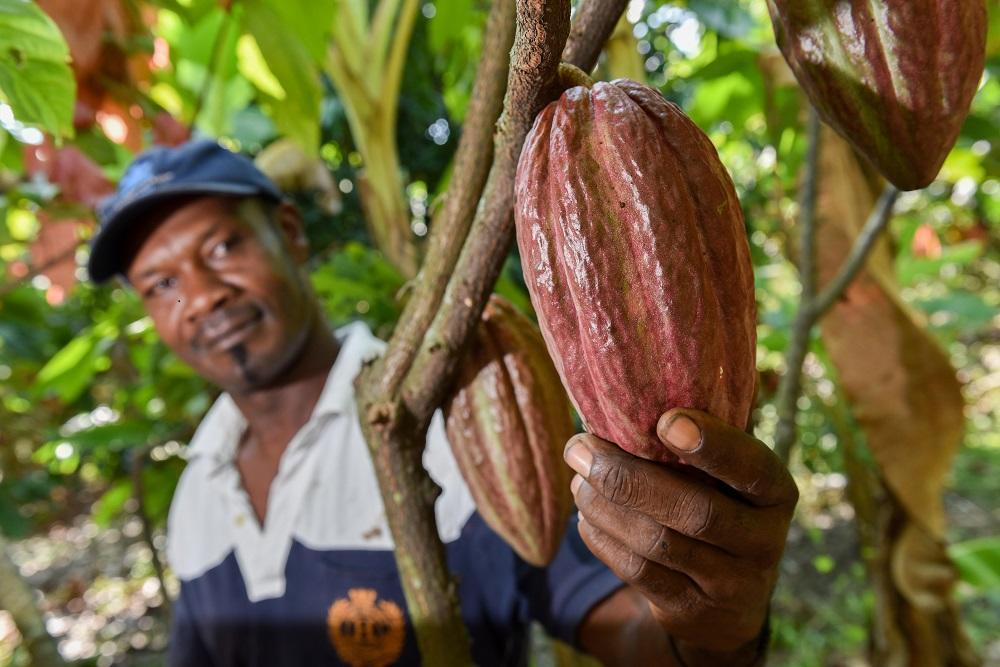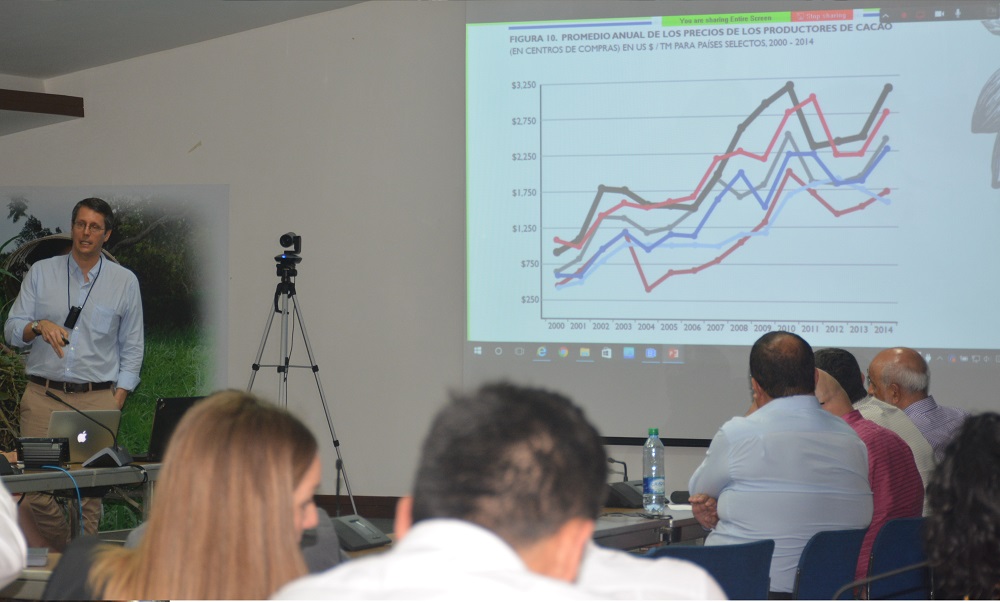What role can cacao for peace play in Colombia?

In the midst of the ten blocks that comprise Remolinos del Caguán, in the Caguán River that borders it and in the Amazon jungle that shelters it, the legacy of father Jacinto Franzoi remains intact: no to coca, yes to cacao.
In this remote town of Cartagena del Chairá, in the department of Caquetá, with no more than 500 inhabitants, and, sadly, a protagonist of the armed confrontation in Colombia, the dream of the Italian priest to see the tenant farmers exchange the green leaves of coca for the intense red of cacao became an obsession. To such an extent that he created the cacao farmers’ cooperative of Remolinos del Caguán and Suncillas (Chocaguán), with which he also sought to retain the population who wanted to abandon their lands when the military operations to counter the narco traffic began, and the coca stopped being profitable.
“It was a difficult task. We were used to easy money. With the coca, after six months we were already making money, and with the cacao, we would have to wait three years, but those concerns were overcome by our farming vocation and the hope of living within the law”
Rubén Darío MontesLike this story, which earned Father Jacinto Franzoi the National Peace Prize in 2004, hundreds of stories throughout the country seem to say that cacao can play a key role in post-conflict development in Colombia. In fact, as affirmed by the ambassador of the United States in Colombia, Kevin Whitaker, during his visit to CIAT on Tuesday, April 25, “the map of the country where there is the most cacao and the map of the zones with the most conflict is more or less the same.”
Nevertheless, the potential of cacao in key post-conflict zones is not a sufficient argument in and of itself to promote it as an alternative for generating income among small scale producers. More and better arguments are required in order to think about cacao as an agent in a competitive sector that is profitable, sustainable, and socially inclusive in Colombia. For that reason, Purdue University and CIAT developed, over the course of a year or so, an analysis of the cacao production chain in Colombia, commissioned by the United States Department of Agriculture (USDA), in the context of the Cacao for Peace, financed by USAID. To deliver the results of this study, the ambassador paid us a visit.
Results of the analysis of the cacao production chain in Colombia

Cacao has a presence in a large part of the Colombian territory; it has existed for millenia, and it has an internal demand that is deeply rooted in the historical tradition of the consumption of table chocolate. Nevertheless, “the recent efforts to promote the cacao sector in Colombia have focused more on the expansion of cacao production than on achieving post-harvest management, establishing producer organizations, and [gaining access to] market niches. Because of that, and in spite of the interventions, the development of this sector continues to fall short of its potential,” says the study developed by CIAT and Purdue University.
Because of that, instead of focusing only on cacao production, the authors of the study propose a different strategy that begins to clarify the roles and the responsibilities in the sector in order to avoid duplications and promote coordination and collaboration among the national and regional actors, with key incentives to improve the practices, as well as improved coordination among the national policies and the relevant investments for the sector. According to the authors, these interventions, along with the combination of specific actions to improve competitiveness and productivity, can help the cacao-producing sector reach its potential.
In summary, four strategies were recommended by the authors of this analysis of the cacao production chain in Colombia:
1. Learn to walk before you run
It is necessary to increase the productivity, the sustainability, and the competitiveness of cacao production. Although the annual production has increased, this increase is due to the expansion of the cultivated area, not to an improvement of yield, which has not changed in the past 60 years. Access to higher value markets without first producing in an efficient manner, with consistent volumes and quality for the internal market, continues to be highly problematic.
2. Build businesses that generate wealth in rural zones
Specific investments are required to strengthen the producer organizations, so that they may be converted into visible rural businesses that follow the clear signals of the market. The associations need to perform efficiently and add value, both to the producer members and to the business associates. It is suggested to concentrate in the sustainability and profitability of the productive organizations and avoid focusing solely on production. In order to make sure that the producers are turning a profit, training must also emphasize managerial and record-keeping skills as a multipurpose productive system, according to the local conditions.
3. Turn producer organizations into good partners
It is necessary to strengthen the sector and respond to the markets with consistent quality and commercial volumes. Finding ways of producing efficiently and profitably for the internal market represents a first step toward potential access to higher value market niches in the future, although these higher value markets may not constitute a broad solution at this time for rural poverty, since the market is very small and very few farmers could benefit from access to it.
4. “Cobbler, stick to thy last”
The institutional architecture of the cacao sector needs to be improved by means of clear rules and specialization. To accomplish this, it is suggested to strengthen the role and the credibility of national and regional institutions such as the National Cacao Council; define a specific role for Fedecacao; improve and take advantage of the National Cacao Fund; improve the effectiveness of Finagro and many other financial providers for the sector; and improve the coordination between the programs of international donors.
“Colombia has a strong potential in cacao farming because it has a very significant domestic demand. Anyone who decides to invest in producing cacao has a guaranteed market. Also, because of its quality, there are new markets that could be interested in the cacao that comes from Colombia”
Tamara Benjamin“The title, cacao for peace, was chosen because we have seen that cacao is present in the conflict zones and is also, for the most part, a product of small and medium-sized producers. Colombia has all the potential to become a great producer of cacao because it has the land and the human capacity. These two together can greatly improve the cacao harvest in Colombia, and give people greater benefits”
Benjamin Rau“We are going to use the results to see what we can do to improve our programs that are supporting the cacao sector in Colombia. And with these results, hopefully in 10, 15, or 20 years, the sector will change, grow, and compete more effectively with other countries of Africa and Ecuador”
Nathaniel BillsYou can see the complete PowerPoint presentation about this study here. And you can also see the videoconference through BlueJeans: https://bluejeans.com/s/IS_bw
A foretaste of the presentation of results: Genetics, management of water and carbon, and climate change projections
On the morning before the presentation of the results of the Cacao for Peace study, the guests of the event, representatives of various public and private organizations with ties to the cacao-producing sector, participated in a day of learning and discussion around various themes in which CIAT has worked with cacao, and which could inspire the development of joint initiatives among some of these actors. These topics were:

Cacao Germplasm Banks: Genetic Diversity and Opportunities, presented by Gerardo Gallego.

Management of water and carbon for cacao, presented by Jefferson Valencia y Miguel Romero.

Projections of climate change for evaluation of impact on crops, presented by Carlos Navarro.
“We are looking for a strategy of how we can cooperate with Fedecacao, with Corpoica, with universities, and above all, with the private sector to build a good alliance to work together on cacao. CIAT is not going to lead this alliance, it is going to provide the information that comes out of the research and we have a great deal of knowledge that could be applied for the benefit of the cacao supply in the future”
Ruben EcheverríaWhitaker: Cinco intensas horas en el CIAT
Además de presentar los resultados del estudio de la cadena productiva del cacao, adelantado por la Universidad de Purdue y el CIAT, ante los medios de comunicación, el embajador de Estados Unidos en Colombia, Kevin Whitaker, tuvo la oportunidad de recorrer las instalaciones del Centro y conocer sobre los proyectos científicos que se adelantan en la institución.
El diplomático visitó el banco de recursos genéticos donde el CIAT conserva las colecciones más grandes en el mundo para fríjol, yuca y forrajes tropicales para alimentación animal, con origen en más de 141 países.
Asimismo, conoció sobre Semillas del Futuro, el proyecto con el que se busca la construcción de un nuevo banco de germoplasma de última generación para la conservación y distribución de los tres cultivos básicos y sus parientes silvestres y visitó la Plataforma de Transformación Genética.
Whitaker también apoyó la iniciativa de un CIAT más verde y sembró una planta de cacao en la plazoleta principal y recorrió la exhibición de la línea del tiempo, en conmemoración de los 50 años de fundación del centro de investigación agrícola.

“We are very committed to helping in crop substitution and alternative development. What are the most important elements? Safety. Without that, it is not possible to undertake this type of effort. Second, the commitment and the will of the people are necessary. It is important for the people of the countryside, who have been affected by the violence, to have the possibility of leading a dignified and law-abiding life”
Kevin WhitakerNumbers
Cacao planted in Colombia
Cacao producers in Colombia
Imports
Annual production of cacao in Colombia
Domestic consumption
Exports

Authors of this blog:

Erika Eliana Mosquera
Communication Analyst

Adriana Varón
Communications Coordinator for Latin America

Natalia Gutiérrez
Communication Analyst
